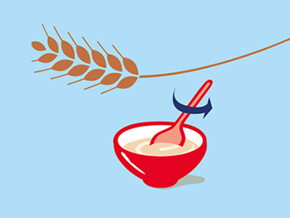
Getting Started On Weaning Foods!
Important Weaning Foods For Your Baby
IMPORTANT NOTICE: The World Health Organization (WHO) recommends exclusive breastfeeding for the first 6 months and continued breastfeeding for as long as possible. Growing up milks are formulated to meet nutrition needs of healthy young children older than 1 year and should not be fed to infants.
The World Health Organization recommends exclusive breastfeeding for a minimum period of 6 months so babies can have all the benefits of their mothers’ mineral and vitamin-rich breast milk, strengthen their immunity and increase their bodies’ capacity to fight infections and diseases.
After these 6 months and at later stages of breastfeeding comes the weaning phase.
What is weaning? It’s the process of gradually introducing different liquids and solid foods into an infant’s diet which depended on breast milk completely since birth, without having to abandon this important source of nutrition.
It’s normal for a mother to get excited when her child reaches this important phase of his development, yet weaning might not be as easy as she expects, and it may require from her lots of knowledge, wisdom and know-how.
What about you? Have your baby reached the weaning phase yet? Are you thinking of introducing your bundle of joy to the world of solid foods but you don’t know from where to start and what kind of tastes and textures to choose?
Let us guide you through the steps for getting started, first with few useful guidelines, then with a detailed list of the most common foods you can offer your baby:
- Begin by serving a small amount of solid food once a day (let it be after your baby’s feed), then gradually build-up the amount.
- Start with easy-to-digest liquid-based foods then move to thicker and lumpier textures.
- Make sure that your baby’s first foods are non-allergenic and easy to digest.
- To facilitate the involvement of your child in this transitional phase, try to add some breast milk to his cooked fruits and vegetables.
- Select your baby’s first foods from the following healthy options:
- Juices: Fresh juices can be an appropriate nutrition for your baby during the weaning phase. Choose the types that you find in the market all year long, like apple juice for example. If you want, you can prepare this juice at home by just following these easy steps: peel an apple, cut it into small pieces, boil it in water until it softens, then mash it well. Let the juice apple accumulate in the strainer, until it’s ready to be served.
- Fruits: It’s very important that you choose ripe and tasty fruits like apples, pears and avocadoes, and you use them to make purees for your baby: peel the fruit of your choice, cut it into pieces, steam it then let it cool before mashing it with a blender or a food processor.
- Vegetables: Vegetables are very essential to your baby’s growth and you must include them in his daily diet after he’s 7 months old. Mashed potatoes can be one of the easiest recipes for your child at this stage. To prepare it, just cook the potato, remove its skin, mash it very well then serve it. The same preparation method applies to the carrots, the squash and the tomatoes.
- Soups: Once your baby is 8 months old, offer him soups made of fresh vegetables.
- Green vegetables: Cook some green vegetables like spinach and turn them into a thick paste that you can offer your child after he’s 8 months old.
- Water: Water is not recommended by the World Health Organization for babies under 6 months old. But after this age and once reaching the weaning stage, water becomes a necessity along with other foods, as it will keep babies hydrated, cleanse their bodies from pollutants and improve their digestion.
Read More: How And When To Introduce Solid Foods To Babies?




















